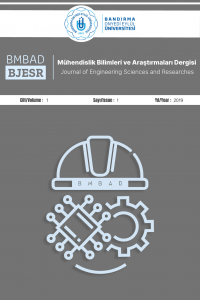Farklı Tip LED Sürücülerin Güç Kalitesi Performanslarının Belirlenmesi
Günümüzde gelişen teknolojiye paralel olarak aydınlatma alanında yeni nesil ürünler ortaya çıkmakta ve mevcut sistemlerde iyileştirmeler yapılmaktadır. Bu iyileştirmeler genellikle konvansiyonel aydınlatma ürünlerinin ışık yayan diyotlarla (Light Emitting Diode - LED) değiştirilmesiyle gerçekleştirilmektedir. Bu değişimlerin en önemli amacı şüphesiz enerji verimliliğini artırmaktır. LED’ler uzun ömür, yüksek ışıksal etkinlik, renk kontrolü ve çevre dostu gibi önemli özelliklere sahip olmasına rağmen çalışma karakteristikleri gereği bir sürücü devresine ihtiyaç duymaktadırlar. Bu sürücü devrelerinin içerdiği güç elektroniği elemanları LED’lerin sistemden harmonikli akım çekmelerine neden olmaktadır. Bu nedenle LED sürücülerin güç kalitesi üzerine etkilerini analiz etmek ve yorumlamak çok önemlidir. Bu çalışmada, ticari olarak kullanımda olan farklı üreticilere ait LED sürücülerin harmonik içeriği, toplam harmonik bozulumu ve güç faktörü değerleri incelenmiştir. Ayrıca aynı sürücü üzerinden farklı sürme akımlarında ölçümler yapılarak sürme akımlarının güç kalitesine etkisi ortaya konulmuştur. Çalışma sonucunda, farklı üreticilere ait LED sürücülerin güç kalitesi üzerine önemli etkilerinin olduğu ve bu etkilerin sürme akımına bağlı olarak değiştiği görülmüştür.
Anahtar Kelimeler:
LED Sürücüler, Güç Kalitesi, Harmonik, Güç Faktörü
Determination of The Power Quality Performances of Different Type LED Drives
Today, in parallel with the developing technology, state of the art products are used in the lighting area and improvements are made in existing systems. These improvements are generally achieved by replacing conventional lighting products with light emitting diodes (LEDs). The most important aim of these changes is undoubtedly to increase energy efficiency. Although LEDs have important features such as long lifetime, high luminous efficacy, color control, and eco-friendly, they need a driver due to their operating characteristics. The power electronics components in these drivers cause the LEDs to draw harmonic current from the system. Therefore, it is very important to analyze and interpret the effects of LED drivers on power quality. In this study, harmonic content, total harmonic distortion and power factor values of LED drivers of different manufacturers in commercial use have investigated. In addition, the effect of the driving currents on the power quality has determined by making measurements at the same driver at different driving currents. As a result of the study, it is seen that LED drivers which belong to different manufacturers have significant effects on power quality and these effects change depending on the driving current.
Keywords:
LED Drivers, Power Quality, Harmonics, Power Factor,
___
- [1] Radwa M. Abdalaal, Carl Ngai Man Ho, “Characterization of commercial LED lamps for power quality studies”, IEEE Electrical Power and Energy Conference (EPEC’17), 22-25 Oct., Saskatoon, SK, Canada, 2017
- [2] Himanshu Swami ; Amit Kumar Jain ; Inamul Haq Azad ; Neeraj Meena, “Evaluation of input harmonic characteristics of LED lamps connected to utility grid”, IEEMA Engineer Infinite Conference (eTechNxT’18), 13-14 March, New Delhi, India, 2018
- [3] Abdelrahman Ahmed Akila, Kamelia Youssef ,Ibrahim Yassin, “Harmonics Monitoring Survey on LED Lamps”, Renewable Energy and Sustainable Development (RESD), Vol. 3, Issue 1,pp. 39-45, March 2017
- [4] S Adhigunarto, E Mulyana, W Surya, “The Analysis of Harmonics on LED Lamps”, International Symposium on Materials and Electrical Engineering (ISMEE’17), 16 Nov., Bandung, Indonesia, 2017
- [5] Piyush Verma,, Nitish Patel, Nirmal-Kumar C. Nair, “CFL to LED Transition: An Analysis From Harmonics Perspective”, IEEE International Conference on Power System Technology (POWERCON’16), 28 Sept.-1 Oct., Wollongong, NSW, Australia, 2016
- [6] Salvatore Di Mauro, Salvatore Musumeci, Angelo Raciti, Gaetano Vasta, “Analysis of the current harmonics injected into the power grid by dimmable LED lamps”, AEIT International Annual Conference (AEIT’16), 5-7 Oct., Capri, Italy, 2016
- [7] Ratnesh Kumar Pandey, S.P.Tondare, “An AC LED Driver with Improved Total Harmonic Distortion and Power Factor”, International Journal of Scientific & Engineering Research, Vol. 7, Issue 5, pp. 1532-1538, 2016
- [8] C. Jettanasen, C. Pothisarn, “Analytical Study of Harmonics Issued from LED Lamp Driver”, Proceedings of the International MultiConference of Engineers and Computer Scientists 2014, Vol II, Hong Kong, 2014
- [9] Josué Pacheco Chérrez, Brian Loza, L.G. González, “Design And Analysis Of Performance And Power Quality Of A Led Driver”, IEEE International Autumn Meeting on Power, Electronics and Computing (ROPEC’17), 8-10 Nov., Ixtapa, Mexico, 2017
- [10] Wakileh, G. J., “Power System Harmonics”, Springer-Verlag, Berlin, 2001.
- [11] Jos Arrillaga, Neville R Watson, “Power system harmonics”, John Wiley & Sons, 2004
- ISSN: 2687-4415
- Yayın Aralığı: Yılda 2 Sayı
- Başlangıç: 2019
- Yayıncı: Bandırma Onyedi Eylül Üniversitesi
Sayıdaki Diğer Makaleler
REZONANS DÖNÜŞTÜRÜCÜLÜ FOTOVOLTAİK BATARYA ŞARJ SİSTEMİ
FOTOVOLTAİK PANELİN TEK DİYOTLU MODELLENMESİ
AĞIRLIKLI ARTIK YÖNTEMLERİN SINIR TABAKA PROBLEMLERİNE UYGULANMASI
Farklı Tip LED Sürücülerin Güç Kalitesi Performanslarının Belirlenmesi
Erdem TÜRKMEN, Ramazan AYAZ, Kadir DOĞANŞAHİN, Bedri KEKEZOĞLU
İNDÜKSİYON ISITMADA ÇALIŞMA FREKANSININ ISITMA DERİNLİĞİNE ETKİSİ
Adem DALCALI, Harun ÖZBAY, Selim ÖNCÜ
Fıstık Kabuğu Üzerinde Sulu Çözeltilerden Adsorpsiyon İle Kongo Kırmızının Uzaklaştırılması
